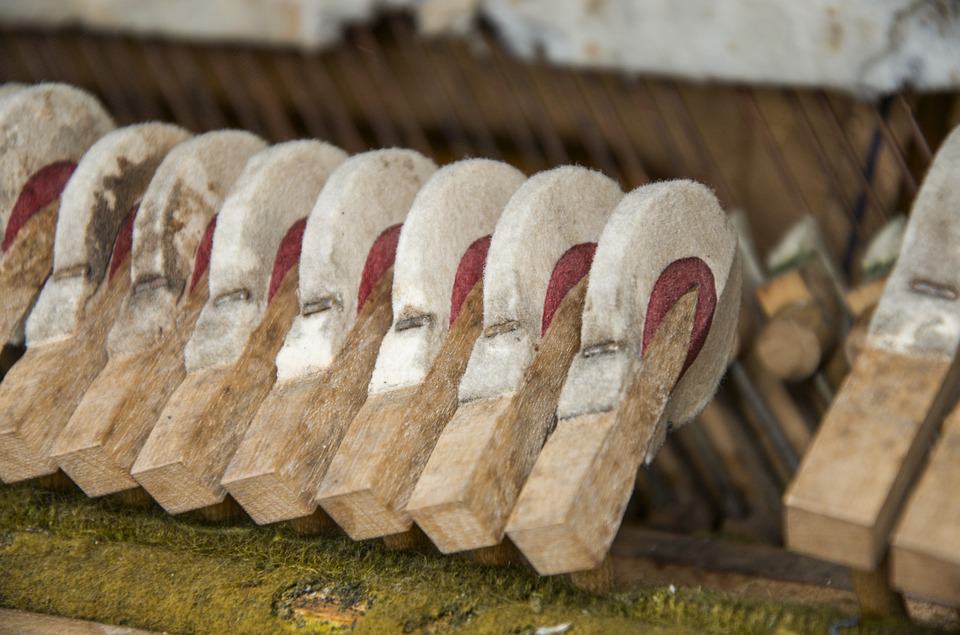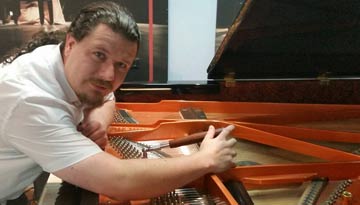 Previously we’ve talked about the choice between digital or acoustic pianos, and, if you go acoustic, what kind of piano you might choose. If you’ve come this far, you might be ready for the next question – new or second-hand? Those new beauties look shiny in the showroom, but they can sure be expensive! Yet the basic design of a piano has barely changed in decades, and there are lots of older pianos that still have life in them. You just need to be armed with the understanding that a piano is a unique individual who needs to be understood.
Previously we’ve talked about the choice between digital or acoustic pianos, and, if you go acoustic, what kind of piano you might choose. If you’ve come this far, you might be ready for the next question – new or second-hand? Those new beauties look shiny in the showroom, but they can sure be expensive! Yet the basic design of a piano has barely changed in decades, and there are lots of older pianos that still have life in them. You just need to be armed with the understanding that a piano is a unique individual who needs to be understood.
Let’s begin with a few general words of advice:
-
If you’re a beginning player and are not confident in your own judgement of the instrument’s playability, see if you can have a friend who is a good player try it out.
-
You’re almost certain not to be confident about what’s under the hood. The inner workings of a piano are mostly the domain of experts. The cost of having a piano technician give it a good examination may well repay itself many times over, especially in the case of a second-hand instrument. If they think it needs some work, that doesn’t necessarily strike it off your list, but see if they can give you an estimate of the repairs. This might even add a little power to your negotiating arm.
-
Regardless of that, you will definitely need to factor some extra costs into the overall price. How much is anyone’s guess, but a technician’s guess will be a lot better than yours. Common candidates for reconditioning include hammers and key bushes, or more seriously, repairs to the complex mechanism between key and hammer. If you don’t need that, there may still be a need for regulation of the action, voicing of the hammers and other maintenance, and a tuning is always necessary after delivery, even for a new piano.
Potential Pitfalls
Obviously a new instrument is a safer bet, but compared to many modern machines, pianos are usually long-lived and sturdy. A second-hand instrument can be an equally serviceable and much more affordable alternative to something fresh out of the packing crate. Let’s just get real about the potential pitfalls and we can be empowered to make the best decision for our needs.
Obviously, like most things, the newer a second-hand piano is, the lower is the risk of needing major work. But unlike most other machines, a piano is really like a living thing. The wood especially breathes and moves in response to its environment. A well-cared-for middle-aged piano might be a better bet than a newer instrument that’s been stored in questionable conditions. Ask how it’s been looked after. Has it been regularly serviced? Has it ever been kept in a storage space like a garage? Even inside a house, a piano located against an external wall will feel the weather more than one facing a wall between two rooms.

Pianos are generally built to last, but some more so than others. For example, better-known German and Japanese instruments as much as 30 years old tend to have higher quality parts that are easier to replace or restore. For second-hand instruments, it’s safest to stick with the respected brands. And by the way, a German-sounding name does not necessarily mean a German piano. Check where it was built. If it came from China or Korea instead, that doesn’t necessarily eliminate it, but it might pay you to ask your technician if they know the brand.
Perhaps you’re setting your sights even further back. One hundred or so years ago pianos were almost as common in family homes as televisions are today, and they were typically solidly-built with beautiful cabinetry. You may even have one sitting forlornly in a corner waiting to be restored to its former glory, or you may see a “fully rebuilt” gem in a store glowing with new lacquer and sporting new strings and action, but there’s one area that’s beyond the scope of most restorers – the soundboard. That’s the big panel behind the frame, and it’s a vital part of a good sound. Over time the cellulose in its timber shrivels and dries like a kitchen sponge. This natural process pretty much guarantees that an old instrument won’t have the power and brilliance of its heyday, even if well-kept. A restoration that your Great-Granddad’s pride and joy deserves will be a pretty penny, and if it doesn’t include the soundboard, it might still disappoint compared to a bland-looking but younger instrument. And also, the older the instrument, the greater the chance of some unsavoury infestations in its dusty depths (believe me, I’ve seen them!).
Buying a piano from a retailer might be a better bet than a private seller, but it isn’t an automatic assurance of quality, or even decent preparation. Any piano will need at least a modest inspection and basic setup before it’s on sold. It doesn’t take a lot of time or expertise to look inside, run the vacuum cleaner over the poor thing and check everything is in working order. Ask what the dealer has done to prepare it for sale. At the very least, ask for a look inside (for an upright, take off the panel below the keyboard) and have a look for dust and cobwebs. If it hasn’t even had a basic clean, there’s every chance it won’t be in optimum playing order.
Interestingly, even buying a new piano can have its risks. Unfortunately, not every seller will take the time to properly set their instruments up to suit local conditions. For example, thanks to the wooden components, a piano will take some time to ‘bed in’, especially in its first few months, and most especially if it’s experienced a journey halfway across the world to get to the store. It will have been regulated in the factory, but it will need to be regulated again at the store. Not every retailer will take the time to do this properly, if at all. Sometimes the factory will even over-regulate it to allow for uncertain showroom conditions. Unless you know the store well, it may pay to have a technician you know and trust (who preferably knows the brand well) to look over it. As well, typically a new purchase will include the first tuning. You might arrange for them to do this work if the store is willing to knock that component off the price. They can add to that basic tuning a little work to set up the action the best way for you.
You may find there’s a seller who seems able to dramatically undercut their competition, selling current or recent models for way less than anyone else. These may be “grey” or parallel imports, pianos brought into the country outside of the brand’s official dealer network. These instruments may seem (and may even be) amazing value, but beware! They may be of questionable provenance, including being sourced from locations whose climate doesn’t suit a piano’s delicate sensitivities. They may be poorly reconditioned, and if worse comes to worst, you may even struggle having the warranty honoured. Yes, give that unbeatable bargain a look over, but remember the age old adage: if something seems too good to be true, it probably is.
Well, I hope I haven’t completely burst your bubble! Don’t worry – you really can find a piano you will love for years at a good price. Just walk in with your eyes open and be prepared to walk out with your wallet closed! If the head drives the choice, the heart can follow.

Vincent Tarin is a French-born piano technician, graduating from The Itemm Academy, Le Mans as a fully certified piano tuner, working subsequently in Ireland and doing further training in Germany, before settling in Melbourne. He is a member of the BDK guild and a certified concert piano technician, and is experienced in workshop, client service, concert and factory work. In his spare time he loves to play the theremin and musical saw.







